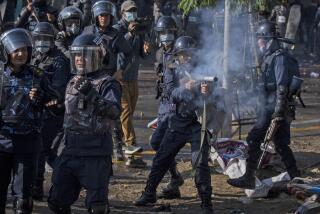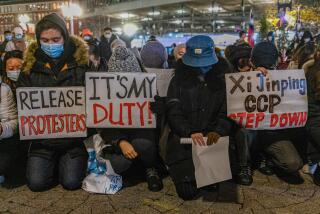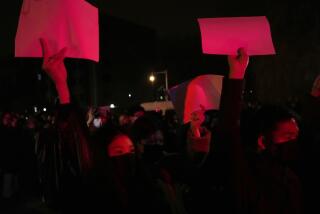6 Killed in Tibet Anti-Chinese Riot : Lhasa Demonstration for Independence Leads to Violence
- Share via
BEIJING — Six people were killed and a police station was burned in an anti-Chinese riot by about 2,000 Tibetans in Lhasa on Thursday, according to reports reaching here Friday and today.
The incident began when several dozen people, including about 10 in monks’ robes, staged a demonstration in a street called Bajiaojie that runs around the Jokhang Temple in central Lhasa, the official New China News Agency reported.
“They carried the flag of ‘the snow mountains and lions,’ a religious icon of Tibetans, and shouted the slogan ‘Independence for Tibet,’ ” the agency said.
“When policemen came out to stop their unlawful activities of splitting the motherland and sabotaging stability and unity, the rioters threw stones at the policemen and the common people here, set the Bajiaojie police substation on fire and destroyed a number of motor vehicles.
“Some rioters went so far as to snatch away guns carried by policemen and opened fire at the police and common people on the spot.”
19 Policemen Injured
The Chinese news agency reported that “according to police officers, throughout the incident they strictly observed the orders of the higher authorities not to open fire. Six people were reportedly killed and 19 policemen were badly injured,” the news agency said.
The agency’s report gave no figure for how many people joined in the rioting, but tourists returning from Tibet who spoke with Western reporters in the central China city of Chengdu indicated there were about 2,000.
Travelers’ accounts of the incident were similar to the official news agency’s as to how the riot started and how many deaths there were. Some tourists, however, said the police had fired their weapons. Reports also left it somewhat unclear how many people rioted and how many just watched.
The French news agency Agence France-Presse reported that travelers returning to Chengdu said the demonstrators, surrounded by thousands of onlookers, burned at least five police vehicles.
“I saw one man lying on the ground with a piece of his skull blown off and blood pouring out of his head,” Lar Pettersson, a Swedish tourist, told AFP.
The riot was the second protest in Lhasa in five days. The New China News Agency reported earlier this week that on Sunday, 21 monks and five other people staged a similar demonstration and made “agitating speeches” at the Jokhang Temple Square.
“Some demonstrators were held for questioning” after they “hit and injured several police officers on the scene,” the agency said.
The Associated Press reported that the CBS television network said a traveler from Lhasa told its Hong Kong office that about 20 Chinese police were injured in Sunday’s clash, one seriously.
The traveler also told CBS that two Americans, believed to be tourists, were arrested after Sunday’s demonstration. The network said they were John Ackerly of Cambridge, Mass., and Blake Kerr of East Hampton, N.Y.
A spokeswoman for the U.S. Embassy in Beijing said Friday evening that she had no information about any Americans detained in Lhasa.
The traveler said Sunday’s demonstrators distributed information about the visit to the United States last month of the Dalai Lama, Tibet’s former theocratic ruler who fled to India after an abortive 1959 uprising against Chinese rule.
While in Washington last month, the Dalai Lama spoke to a congressional human rights subcommittee, outlining a five-point proposal calling for a halt in the movement of ethnic Chinese into Tibet, respect for human rights and freedoms of Tibetans, a stop to what he said is the production of nuclear weapons in eastern Tibet, declaration of Tibet as a demilitarized zone of “peace and nonviolence,” and negotiations on Tibet’s future status.
China responded by calling the subcommittee’s action in providing a platform for the Dalai Lama “wanton interference in China’s internal affairs.” The Dalai Lama’s proposal “is aimed to pursue the ‘independence of Tibet,’ splitting the motherland and sabotaging unity among China’s various nationalities, “ China’s state nationality affairs commission said in a statement reported by the New China News Agency.
“Any attempt to split Tibet away from the motherland . . . will never succeed,” the commission said. “Tibet has been part of China’s territory since ancient times, and since the 13th Century, China’s central government has been exercising full sovereignty over Tibet.”
Monasteries Were Razed
Historically, Tibet has sometimes been part of China and sometimes independent. It was incorporated into the Chinese empire under a succession of strong dynasties since the 13th Century, but enjoyed de facto independence during periods of dynastic weakness and after the 1911 overthrow of the Qing Dynasty. It has been firmly controlled by Beijing since 1951.
China governed Tibet with great repression during the 1966-76 Cultural Revolution, when the region was totally isolated from the rest of the world. At a time when religion was suppressed throughout China, a majority of Tibet’s monasteries were razed.
But since 1979, China has allowed a measure of religious freedom, renovated and reopened more than 200 monasteries, and allowed visits by tens of thousands of foreign tourists.
The official newspaper People’s Daily said in a commentary published today that the riot Thursday “is a serious political incident instigated and engineered by the Dalai clique.”
“The territorial integrity of China brooks no encroachment and the internal affairs of China brook no outside interference,” the commentary said. “Dalai is openly trumpeting for the independence of Tibet in the United States and some other countries, and he will never succeed in his divisive activities by courting the support of foreigners.”
Thursday’s demonstration became a riot when the crowd of Tibetans turned its anger on the police after the arrest of the demonstrating monks, witnesses said.
Leon Schadeberg, a free-lance photographer from London, told the Associated Press in Chengdu that when he arrived at the temple square after the arrests, he saw “a few thousand people facing the public security bureau (the police station), shouting.
“More police were arriving and the demonstrators started throwing stones at the police trucks and smashing the windows,” he said. “Some (police) came forward with guns threatening to shoot. But the demonstrators just came forward and started pushing them around. There was some sort of scuffle when they got one policeman down on the ground.
“They smashed up the pavement and got stones from the ground,” Schadeberg said. “There were ladies coming forward with bags of stones and dropping them for the crowd to throw.”
More to Read
Sign up for Essential California
The most important California stories and recommendations in your inbox every morning.
You may occasionally receive promotional content from the Los Angeles Times.










